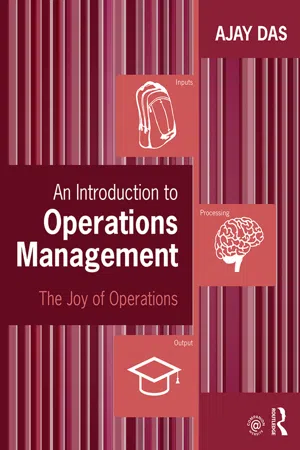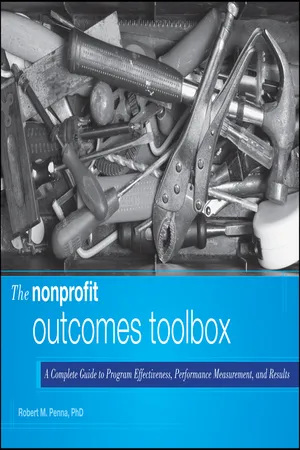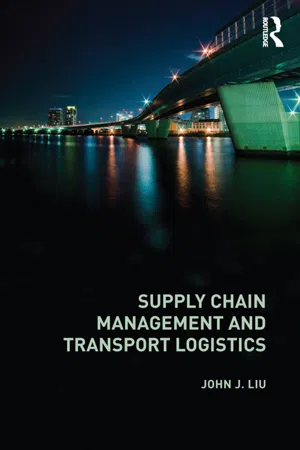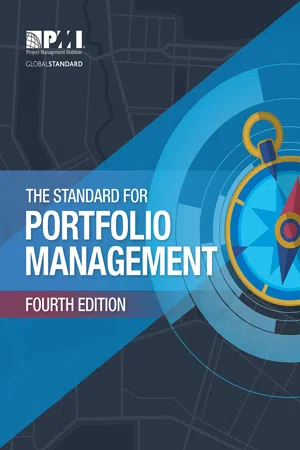Business
Capacity
Capacity in business refers to the maximum level of output a company can produce, or the resources it can effectively utilize. It encompasses both physical and human resources, and is crucial for determining a company's ability to meet demand and grow. Understanding and optimizing capacity is essential for efficient operations and strategic planning.
Written by Perlego with AI-assistance
Related key terms
9 Key excerpts on "Capacity"
- Steve Brown, Kate Blackmon, Paul Cousins, Harvey Maylor(Authors)
- 2013(Publication Date)
- Routledge(Publisher)
Capacity decisions are one of the key policy decision areas for operations. Like other policy decisions, this involves making trade-offs between investing in productive resources and making the best use of them. On the one hand, transforming resources such as facilities, technology, and people are generally expensive and take time to acquire or create, so the organization wants to use them wisely. On the other, materials, information and effort may be wasted if they are acquired or transformed when there is no demand for them, while sales may be lost if outputs are not available when needed by consumers.Defining Capacity
In operations management, the term Capacity describes the level of output that the organization can achieve over a specified period of time. Capacity can be defined in several different ways, and some of these are described below.Theoretical Capacity
One definition of Capacity is the maximum level of output that can be attained by the organization, theoretical Capacity, which is the level of output that can be achieved if the organization's resources are used fully. This would mean operating 24 hours per day, 7 days per week, 365 days per year, and for all but continuous production this is clearly unrealistic.Many manufacturing operations and most service operations operate either during fixed hours, such as 9 am to 5 pm, Monday to Friday, or have some periods where operations are minimal. A university might be able to double or triple the level of students through scheduling lectures around the clock, including weekends and holidays, which would make very efficient use of its lecture theatres; however, it wouldn't be very popular with students or faculty!Design Capacity
Even facilities running continuously find it difficult to achieve 100 per cent productive time; they must generally shut down at least periodically for maintenance and cleaning. A second definition of Capacity is design Capacity- eBook - ePub
- Falconer Mitchell, Hanne Nørreklit, Morten Jakobsen(Authors)
- 2013(Publication Date)
- Routledge(Publisher)
When a company acquires a production factor, it becomes the owner of a resource capable of producing a specific output, whether tangible or intangible. More generally, the company can be considered a system of resources that exists for the production of goods or services. If we are talking of a resource of a company, the maximum amount of output that can be obtained from it is its maximum Capacity.The level of resources needed is related to the ‘potential income’ that a company can obtain and therefore is a measure of its ability to create value (McNair, 1994).The available Capacity has an influence on several competitive dimensions, namely quality , cost and time (Ansari et al., 1997): product/service quality required by customers can be affected by the Capacity available to fulfil demands for product/service features; investments in Capacity create a cost structure that determines production efficiency; and Capacity and output rates (production speed) contribute by achieving short time to market and adequate flexibility of production systems.The root of the Capacity issue lies in the fact that most of the resources in a business are committed resources . Organizations incur an actual cash outlay to acquire such resources needed for current or future activities. For example, the acquisition of buildings and equipment supplies a Capacity for work in future years. The committed resources generate costs that represent long-term activity Capacity. We can refer to this potential provision in term of the ‘activities’ these resources make it possible to perform in each of the periods considered, according to the following equation (Cooper and Kaplan, 1992):Available Activities = Used Capacity + Unused CapacityFrom an economic standpoint, the value of acquired resources is a committed cost that is independent from its level of use. The latter influences the level of profitability and of course will be the maximum (i.e. converging with the potential) when full Capacity is used effectively. A level of less than optimum use gives rise to costs of unused Capacity – missed opportunities, wasted resources. Capacity utilization, on the other hand, is not good per se: output produced has to be sold and revenues converted to cash in order to gain benefit and effective performance.1 - eBook - ePub
An Introduction to Operations Management
The Joy of Operations
- Ajay Das(Author)
- 2015(Publication Date)
- Routledge(Publisher)
Capacity planning is the acquisition and development of Capacity to meet anticipated user demand. Capacity planning does not always target 100 percent fulfillment of user demand or 100 percent utilization of available Capacity.- The goal of Capacity planning is to minimize the discrepancy between demand and Capacity in a cost-effective, revenue-effective, quality-effective, and safety-effective manner.
- Capacity is the upper limit of a system’s ability to make, store, deliver, or receive products or services at a point in time.
- Design or peak Capacity is the maximum output Capacity possible, usually sustainable for a short period of time.
- Effective Capacity or the best operating Capacity level is the Capacity of the resource under normal operating conditions
- Fixed Capacity represents investments in assets that cannot be reversed easily such as land, equipment, and permanent hires (or classroom Capacity by law).
- Variable Capacity represents investments that can be recovered or changed relatively easily, such as outsourcing contracts, personnel overtime, and temp hiring.
- With standard products, Capacity can be measured in terms of finished product or service output, e.g. number of cars/year; number of pizzas/day, number of rooms.
- With multiple products, Capacity can be measured in terms of input resource availability, e.g. number of ER doctors available per shift, number of beds.
- Capacity utilization is the amount of design Capacity that is utilized on average in fulfilling demand. Capacity utilization cannot exceed design Capacity:
Capacity Utilization % =Efficiency is the amount of effective Capacity that is utilized on average in fulfilling demand:Actual average output or extent of resource use Design Capacity* 100Efficiency % =Actual average output or extent of resource use Effective Capacity* 100A high efficiency ratio is not necessarily good news if the effective Capacity is low relative to design Capacity on account of poor maintenance, poor quality, or worker mismanagement. A high utilization ratio may also increase costs exponentially under conditions of high uncertainty. - eBook - ePub
- Bob Johnson, Alan Hart(Authors)
- 2007(Publication Date)
- Routledge(Publisher)
3 Managing resources In the Introduction to this book, we stressed the need for operations to be: effective – delivering the right product or service, one that meets the needs and wants of your customer, on time, every time efficient – using the fewest possible inputs to deliver the product or service to specification, keeping costs and waste to a minimum responsive – accommodating changes in political, economic, social, technological, legal and environmental factors, in the marketplace and in customer demand, in order to ensure that your product or service and the methods used to produce and deliver it are consistent with market needs and best practice. To achieve these three criteria, it is necessary for the operations manager to control four key elements: physical Capacity operating schedules inventory of both raw materials and finished stocks staff capability. In this chapter, we will consider each of those four elements in turn. MANAGING Capacity Capacity levels All operations have: an optimum Capacity. This refers to the level of output which is consistent with efficient and economic running of the operation, whilst still allowing time for maintenance of the resources used. This may be physical maintenance of equipment and machinery, particularly in the case of a manufacturing operation, or the training and development of staff if the operation is heavily dependent on its people resource. a maximum Capacity. This refers to the level of output which makes fullest use of all the resources required by the operation. When running at maximum Capacity, an operation will have all its machinery running at full speed, with no time for any maintenance other than running repairs. Staff will be working as much overtime as they are prepared to work or as much as they can be allowed to work without falling ill or endangering their own safety or the quality of the output - eBook - ePub
- R. Quentin Grafton, James Kirkley, Dale Squires(Authors)
- 2017(Publication Date)
- Routledge(Publisher)
In other words, Capacity output is defined as the maximum possible output that can be produced given the technology and the input level. Output cannot be expanded beyond YC, because of technological or production constraints. We stress that the measure of Capacity output is purely a technological concept defined by the production frontier and, therefore, is independent of prices and costs. Thus whether it would be economically profitable to produce at Capacity output cannot be resolved without further information. Economic Concept of Capacity An economic, as opposed to technological, measure of Capacity and Capacity utilization is more difficult to define because we have to compare current or observed levels of output to some ‘ideal’, rather than to some maximum level of output. The metric or unit of measurement used by economists for determining the ideal output can vary. It may be defined by costs of production, where the ideal or Capacity output is that which minimizes costs (Morrison 1985), or it might be defined as the level of output that maximizes revenues (Färe et al. 2000a) or profits (Coelli et al. 2000). The most commonly accepted economic concept of Capacity output in the short run corresponds to the output level where short-run average cost and the long-run average cost curves are tangent to each other. This is illustrated in Figure 4.2 where the large U shape curve represents long-run average cost. This long-run curve maps the relationship between the average cost of production and output when all inputs (fixed and variable) can be changed. The long-run curve can be thought of as a ‘lower envelope’ of many smaller short-run average cost curves such that every point on the long-run average cost curve corresponds to a tangency with a short-run average cost curve. For example, points D, B and E represent tangent points for three different short-run cost curves and the long-run curve is constructed from a set of these and other tangent points - eBook - ePub
- Paul Rouse(Author)
- 2011(Publication Date)
- Business Expert Press(Publisher)
Both the planning and management of resource acquisition and operations in a perfect world would be so accurate that available Capacity and resource usage match exactly. In practice, we may overestimate requirements or resources may be “lumpy” (e.g., we may be able to acquire resources only in specified quantities). For example, we may acquire factory space that exceeds the space required by activities, thus leaving space unused. Further, the resources supplied to a particular activity may exceed the resources demanded by the outputs.At both points, there is unused Capacity, representing the difference between resources acquired and resources consumed. This has potential implications for the cost of outputs, which we consider later in this chapter.Acquiring and Consuming ResourcesSome resources are used immediately and this is assured where a business applies just-in-time principles; materials are used immediately, as are short-term labor and purchased services. Where resources are not used immediately, such as premises under long-term lease, or workers under long-term contract, they provide Capacity for activities over a period of time.Maguire and Heath draw a distinction between Capacity management and Capacity costing, such that Capacity management is a broad concept of which Capacity costing is a subset, as Capacity management concerns decisions about the optimal use of existing facilities and also decisions about expansion, contraction, replacement, or the use of alternative technologies.For costing purposes, Capacity is defined and measured in terms of the facility being used to provide the product or service. The theoretical Capacity of a facility is therefore defined in terms of that facility. It excludes speculation about future technologies or even whether the facility is the most appropriate facility given the task being performed.9What Is the Capacity of Your Business?How would you go about measuring Capacity? A variety of definitions of Capacity exist; in general, the Capacity constraint represents the committed resources in the business that managers are responsible for making the best use of, and unused Capacity represents wasted resources. To manage Capacity, we need to define what is meant by available Capacity and then measure Capacity utilization. The following are some commonly used Capacity measures:10 - eBook - ePub
The Nonprofit Outcomes Toolbox
A Complete Guide to Program Effectiveness, Performance Measurement, and Results
- Robert M. Penna(Author)
- 2011(Publication Date)
- Wiley(Publisher)
knowing where you want to go, or even knowing how you intend to get there, is not enough if you do not have the Capacity necessary for getting through the journey . Yes, everyone knows that if you run out of gas, you’re not going to get where you’re going, but the issue goes deeper than that. It has to do with the strengths and competencies you start with. But what, exactly, is this consideration called Capacity, and how is it measured?For many practitioners, at least on an emotional and instinctive level, the words capability, Capacity, ability , and resources often come down to thinking about money. When we hear of an under resourced organization, many of us think first of a group that is struggling on scant financial resources; in many ways, this is understandable—a natural outgrowth of the fact that money is the essential lifeblood of our organizations and their work. As many an organizational leader, CFO, or treasurer knows, there are few crises more threatening or unnerving than a fiscal shortfall. The loss of a funding stream is potentially more than merely a challenge for most organizations: If large enough and irreplaceable enough, it can literally spell the end of an organization and its ability to carry out its mission. At a minimum, it generally means a downsizing of programs, reach, or staff—or all three. So it is natural for many of us to think of finances first when the issues of Capacity or resources are raised. But the fact is that all of these words—capability, Capacity, ability, and resources —mean far more than just money.Instead, all of these words focus on the totality of the characteristics and assets an organization brings to the situation it intends to address. One way to make this issue a bit more clear is to think of organizations as having and needing to account for three sets of capacities, each speaking to a different level of organizational need, strength, and ability. We can look at these three elements as structural, functional, and implementation capacities.Structural capacities - eBook - ePub
- John J Liu(Author)
- 2011(Publication Date)
- Routledge(Publisher)
effective Capacity decisions in the operational short term, as opposed to strategic long-term capital decisions. Clearly, effective Capacity (or simply Capacity for short) depends on the underlying production scheme and schedule, including production structures and strategies. Typical production structures include make-to-stock and make-to-order, and typical production strategies include actions that affect the production rate (e.g., the workforce and the process rate), and production schedule (e.g., work shifts, overtime, and subcontracting). We have shown that the Capacity of a given system behaves quite differently under an MRP system in comparison to other Capacity systems. The Capacity planning to be studied in this section describes a short-term planning and control process, outlined as follows:Capacity planning is used to determine a plan that specifies the sequence of actions that should take place under a given set of viable strategies, to achieve the most effective Capacity to meet a target (e.g., demand or order).As most Capacity systems in manufacturing cannot be characterized by simple analytical models, we need to apply adaptive planning solutions to a manufacturing Capacity system. The outcome of Capacity planning is in the form of a Capacity plan that contains a sequence of structures, under which actions are to take place. To select the best plan, there is a performance measure associated with each Capacity plan. As illustrated in Figure 2.11 , the process of Capacity planning is an adaptive system in pursuit of a given target. As studied in Chapter 1 , an adaptive system consists of three basic elements: the environment, an adaptive plan, and a performance measure. A framework for adaptive planning is constructed and proposed by Holland (1992) - eBook - ePub
- (Author)
- 2017(Publication Date)
- Project Management Institute(Publisher)
The Capacity and capability management function plays a critical role in the organization's overall portfolio management—from strategic planning to portfolio selection and optimization, through portfolio execution, to realizing the resulting value to the organization. Effective and efficient Capacity and capability management bridges the gap between an organization's overall strategy and the attainment of specific business objectives through the monitoring and controlling of the execution of program and project efforts managed within the portfolio structure. Terms are described as follows:- Capacity and capability management. A comprehensive framework based on a set of guiding principles, consisting of a set of tools and practices to identify, allocate, and optimize resources for maximizing resource utilization and minimizing resource conflicts in portfolio execution. Capacity and capability management in the context of portfolio management implies all aspects of resources such as staff, capital, technology, equipment, etc.
- Capacity management. Addresses what types of resources are needed, how many are needed, and when resources are needed to support portfolios.
- Capability management. Elaborates what aspects of resource Capacity are available and addresses the attributes, competences, and skills associated with resources and organizational support for portfolios.
The objective of Portfolio Capacity and Capability Management is to determine the optimal balance between what the organization can do now, or its Capacity, and what the organization can potentially do, or its capability. Portfolio Capacity and Capability Management maximizes resource utilization and minimizes conflicts for successful portfolio execution. Sound practices around portfolio selection and execution, decision making, change management, risk management, value management, and benefit management have a direct impact on resource capacities and capabilities. Interdependencies among portfolio components drive complexity and, thus, affect resources as well. Portfolio Capacity and Capability Management focuses on the human, financial, asset, and intellectual capital resources an organization uses to execute portfolio components. Thus, each organization has an ideal potential as to what it can accomplish and what can be done now, given an entire set of organizational demands and priorities. The portfolio manager needs to look across the organization to identify the programs and supporting projects that will be in the portfolio to meet the strategic objectives of the organization. These programs and supporting projects should also be executable by balancing the portfolio's demands against the organization's Capacity and capability to achieve the business goals of the portfolio and associated value.
Learn about this page
Index pages curate the most relevant extracts from our library of academic textbooks. They’ve been created using an in-house natural language model (NLM), each adding context and meaning to key research topics.








